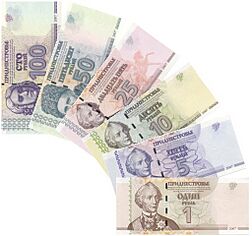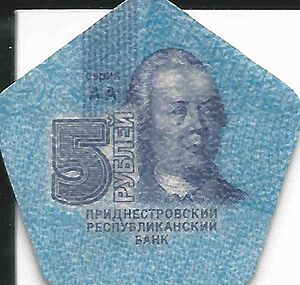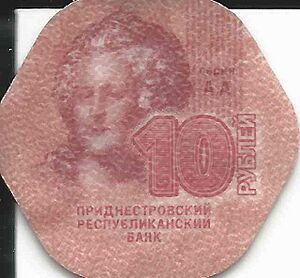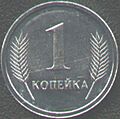Transnistrian ruble facts for kids
Quick facts for kids Transnistrian ruble |
|||
|---|---|---|---|
|
|||
| ISO 4217 Code | none | ||
| User(s) | |||
| Inflation | 10.83% | ||
| Subunit | |||
| 1⁄100 | kopeck копейка (Russian) copeică (Romanian) |
||
| Symbol | |||
| Plural | ruble (Romanian)The language(s) of this currency belong(s) to the Slavic languages. There is more than one way to construct plural forms. See article. | ||
| kopeck копейка (Russian) copeică (Romanian) |
kopecks copeici (Romanian) |
||
| Coins | |||
| Freq. used | 5, 10, 25, 50 kopecks, 1, 3, 5, 10 rubles | ||
| Rarely used | 1 kopeck | ||
| Banknotes | |||
| Freq. used | 1, 5, 10, 25, 50, 100 rubles | ||
| Rarely used | 200, 500 rubles | ||
The Transnistrian ruble is the money used in Transnistria. This is a region that is formally part of Moldova but acts like its own country. However, most other countries in the world do not recognize Transnistria as an independent state.
Because of this, the Transnistrian ruble doesn't have an official international code like other currencies. This means it's not part of global payment systems. You can use cards there, but only on the Russian MIR network. The ruble is divided into 100 smaller units called kopecks.
Contents
How the Transnistrian Ruble Started
After the Soviet Union broke apart in 1990, Transnistria began using Soviet banknotes. When other former Soviet countries started making their own money, Transnistria ended up with many old Soviet rubles.
To protect its money system, in July 1993, Transnistria bought used Soviet and Russian banknotes. They added special stamps to these notes. These stamps showed General Alexander Suvorov, who founded the city of Tiraspol. These stamped notes replaced the old ones.
The Second Ruble (1994–2000)
In August 1994, Transnistria introduced a new ruble. One new ruble was worth 1,000 of the old rubles. This money was only made of banknotes.
However, this currency faced a lot of inflation. This means prices went up quickly, and money lost its value. Because of this, they had to print notes with higher values stamped on them. Some of these notes, even though issued in 1994, were dated 1993.
The Current Ruble (2000–Present)
In the year 2000, Transnistria launched a brand new ruble. This time, 1 new ruble was equal to 1,000,000 of the second rubles! This new money includes both coins and banknotes.
Coins of Transnistria
Transnistria has coins in values from 1 to 50 kopecks. These coins are made from materials like aluminum or copper-zinc. They look similar to the coins used in the Soviet era. The 1 kopeck coins were taken out of use in January 2009.
A unique set of coins was released on August 22, 2014. These coins are made from special plastic materials. They come in values of 1, 3, 5, and 10 rubles.
Special Commemorative Coins
Since 2000, the Transnistrian Republican Bank has also made many special collector coins. These are often made from silver and gold. Only a small number of these coins are made, usually between 500 and 5,000. They feature different themes, like "Ancient fortresses" or "Outstanding people of Transdniestria."
Where Transnistrian Coins Are Made
When Transnistria first started, it didn't have its own place to make coins. So, the Polish Mint in Warsaw, Poland, was chosen to make them. Coins dated 2000 were made in Warsaw and sent to Transnistria through Ukraine.
The government of Moldova was not happy about this. They saw it as a step towards other countries recognizing Transnistria as a real country. In 2001, Moldova's president talked to Poland's leader about it.
The Polish Mint said they were just making "tokens," not official coins, because the Transnistrian ruble wasn't internationally recognized. This was normal for mints to do.
Things got more serious in December 2004. Ukrainian customs stopped a truck carrying Transnistrian coins near Lviv. The coins were given to Moldovan authorities, who again protested to Poland.
In April 2005, Poland's Ministry of Foreign Affairs warned the Polish Mint. They said making Transnistrian coins could harm Poland's relationships with Ukraine and Moldova. The Polish Mint then stopped its contract with Transnistria that same month.
Because of this, Transnistria had to start making its own coins. So, on November 18, 2005, the Tiraspol Mint was opened in Transnistria.
Banknotes of Transnistria
The Transnistrian Republican Bank issues the banknotes. In 2000, they released new notes as part of the currency reform. These notes come in values of 1, 5, 10, 25, 50, 100, 200, and 500 rubles.
2000 Series Banknotes
The 2000 series banknotes feature important figures and landmarks. For example, the 1, 5, 10, and 25 ruble notes show Alexander Suvorov. The 50 ruble note features Taras Shevchenko, and the 100 ruble note shows Dimitrie Cantemir. The higher value 200 and 500 ruble notes, issued in 2004, show Pyotr Rumyantsev and Catherine the Great.
2007 Series Banknotes
In 2007, a new series of banknotes was released for values from 1 to 100 rubles. These newer notes have the same main pictures and themes as the 2000 series. However, they have a fresh design and better security features to prevent faking.
Special Commemorative Banknotes
The Transnistrian Republican Bank also issues special banknotes to celebrate the country's history and important events. These notes have an extra print on them. They are sometimes used in daily life, but many are sold to collectors.
Understanding Exchange Rates
The Transnistrian ruble's value is usually linked to the United States dollar. The central bank decides each workday if the ruble's value needs to change against the US dollar.
For example, on March 20, 2019, 1 US dollar was worth 16.10 Transnistrian rubles. The value of the ruble has changed over time. In 2009, 1 US dollar was 9 rubles. By 2018, it was 16 rubles per dollar.
Using Transnistrian Rubles Outside Transnistria
Generally, the Transnistrian ruble is not accepted as money outside of Transnistria. However, some bus companies that travel to Tiraspol might accept them at the Chișinău bus station. Also, a few local shops in Varnița might take them.
Images for kids
See also







































































